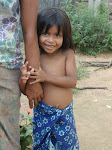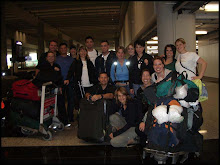The second week involved each team completing more work on the homes of Vijay, Predeep and Nilantha. Cement floors were poured, roofs were constructed and the group's ' interior designers' painted and plastered.
A number of cultural excursions took place. A small group of volunteers spent the day visiting two local schools with Bandulla and Joanne. The first school welcomed us in joining them with their New Year’s celebration. The students provided a beetle leaf welcoming for each of the volunteers. We experienced the tradition of boiling milk in honour of New Year’s prosperity. We then lit ceremonial oil lamps and enjoyed traditional New Year’s foods which consisted of milk rice, cookies, and onion sambal.
Our visit to the second school which was located in a remote rural area, was highlighted by the children’s vegetable garden. Beautiful vegetables and plants were the main focus of our interaction with the students. Some time was spent dispersing gifts brought by the volunteers.
Our last visit of the day was to Navajivina a rehabilitation clinic where we met with the director of the facility, Kumi. We spent a short time touring the facility, stopping at the gift store, where patients exhibited their creative wares. We dropped off sheets, towels, and various medical supplies (splints, tensors, etc) donated by friends and families of the volunteers.
The last work day on each site. A number of bitter sweet moments shared. The team spent an hour this morning visiting each site to experience the accomplishments of the past two weeks. Photos were taken with each team and the families receiving their homes. A collection of gifts were sorted and prepared to present to members of each family.
Our adventures are coming to a close. The last of the team are enjoying celebration of Poya tonight.
The last of the group will be departing at 4 a.m. and 12:30 p.m. tomorrow, respectively, and yes...I will leave with my entourage, a little reluctantly however.
It has been an extremely rewarding and gratifying trip. I look forward to sharing my experiences in person upon my return.
Thursday, April 9, 2009
SRI LANKA: The first week.
The first week has gone very well, with a great deal of progress completed on the homes. The group has been amazing. A good balance of work and relaxation.
It has been wonderful to see our old, dear friends Ruwan, Deepal. Anil, Rohan and especially Jo-Anne Fletcher who has been here since August in a volunteer capacity to support the Kamloops-DWC-Tangalle initiatives. Great hot sunny day have been spent unpacking, organizing, beaching, swimming and lunch. The "cocktails informal orientation" included individual introductions and update on TRIP, DWC and all the activities in Tangalle. The food is always amazing! In particular, the first Sunday curry buffet at Palm Paradise... amazing!
The first full day we visited the village community centre and had a wonderful tea reception from people in and around the community – early New Years to celebrate our arrival – KettakallaWatta.
We met the families and toured the three homes where our group will be working on. Of course there are logistics to take care of and this meant a "Tour of Tangalle" to show all the volunteer participants the bank, internet, and shopping. We also visited the Tangalle Trades Training Facility that the previous Developing World Connections group worked so hard on. And all of this before lunch! After lunch we divided into three groups and worked for the rest of the day.
At Vijay’s house the group painted and plastered. Susan’s team returned covered in white paint but there must have been some on the walls! Vijay and family lived in an original structure, comprised of two small rooms for the past 15 years. The addition of one large main room and two small bedrooms have been added, over the next weeks the work to be completed on home include continued plastering, priming and painting the new additions. By the second project day The team, including Vijay and family began plastering one exterior wall and one bedroom, lots of cement preparation and heavy manual labour. Two coats of primer completed on two original rooms.
At Predeep’s home, the outside walls built to linter, some inside wall work was done – all the rest is opportunity – go Bruce’s team! This original structure has been erected for over 18 years. A rough layout of five rooms, building was recently completed just past foundation level. The Team worked alongside Predeep, family and friends to build up to ceiling height all around the house, in addition to patching all older bricks that were unstable.
At Nilantha’s house good progress was made with major addition to house. The focus is plastering for the awesome Amelie’s team. The original structure consisted of one large room with the addition of two new smaller rooms. The days consisted of the smaller rooms being plastered and the Team worked on sifting sand to remove pebbles and rocks to prepare to make concrete. By the second day the concrete was mixed and the smaller rooms were being plastered, with one full room completed.
The evenings consisted of swimming, laughing, dinner and drinks. Rest and relaxation is well deserved!
On March 31st, the entire group met at the KettakallaWatta Community Centre for lunch. It was the first time that Angie, co-leader, was able to experience the village since volunteering on the first team trip in 2007. Truly a surreal moment.
By the end of the first week, much progress had been made. It was a week full of helping hands, laughter, and hard work but there was time for rest and relaxation too.
It has been wonderful to see our old, dear friends Ruwan, Deepal. Anil, Rohan and especially Jo-Anne Fletcher who has been here since August in a volunteer capacity to support the Kamloops-DWC-Tangalle initiatives. Great hot sunny day have been spent unpacking, organizing, beaching, swimming and lunch. The "cocktails informal orientation" included individual introductions and update on TRIP, DWC and all the activities in Tangalle. The food is always amazing! In particular, the first Sunday curry buffet at Palm Paradise... amazing!
The first full day we visited the village community centre and had a wonderful tea reception from people in and around the community – early New Years to celebrate our arrival – KettakallaWatta.
We met the families and toured the three homes where our group will be working on. Of course there are logistics to take care of and this meant a "Tour of Tangalle" to show all the volunteer participants the bank, internet, and shopping. We also visited the Tangalle Trades Training Facility that the previous Developing World Connections group worked so hard on. And all of this before lunch! After lunch we divided into three groups and worked for the rest of the day.
At Vijay’s house the group painted and plastered. Susan’s team returned covered in white paint but there must have been some on the walls! Vijay and family lived in an original structure, comprised of two small rooms for the past 15 years. The addition of one large main room and two small bedrooms have been added, over the next weeks the work to be completed on home include continued plastering, priming and painting the new additions. By the second project day The team, including Vijay and family began plastering one exterior wall and one bedroom, lots of cement preparation and heavy manual labour. Two coats of primer completed on two original rooms.
At Predeep’s home, the outside walls built to linter, some inside wall work was done – all the rest is opportunity – go Bruce’s team! This original structure has been erected for over 18 years. A rough layout of five rooms, building was recently completed just past foundation level. The Team worked alongside Predeep, family and friends to build up to ceiling height all around the house, in addition to patching all older bricks that were unstable.
At Nilantha’s house good progress was made with major addition to house. The focus is plastering for the awesome Amelie’s team. The original structure consisted of one large room with the addition of two new smaller rooms. The days consisted of the smaller rooms being plastered and the Team worked on sifting sand to remove pebbles and rocks to prepare to make concrete. By the second day the concrete was mixed and the smaller rooms were being plastered, with one full room completed.
The evenings consisted of swimming, laughing, dinner and drinks. Rest and relaxation is well deserved!
On March 31st, the entire group met at the KettakallaWatta Community Centre for lunch. It was the first time that Angie, co-leader, was able to experience the village since volunteering on the first team trip in 2007. Truly a surreal moment.
By the end of the first week, much progress had been made. It was a week full of helping hands, laughter, and hard work but there was time for rest and relaxation too.
PERU: On the Project Site
We have spent two days at the worksite and we have accomplished the following: sanded the cement walls and ceilings, then applied cement filler to patch any cracks or blemishes. Then we applied two coats of primer and it is starting to take shape! We need to fill in any new cracks that appeared after the primer. It will probably need a couple more coats to finish it off. On to anecdotal stuff: Grant almost sanded a scorpion, which was a little freaky but very interesting. Sean McKenna has taken strong liking to the three dogs of the camp. The one he favours the most, the rest of us question if it really is a dog or some alien creature (ugly pictures to follow-of the dog as well). We have had visits at the worksite from the young children who were here last year. Tom remembers them and they certainly remembered Tom (very cute-the kids; not Tom)! The local NGO and our local contractor have been just excellent thus far and we really look forward to working with them for the remainder of this project. As we now have two days under our belt, our initial fears for the weaker sex have proven to be unfounded. The men are working just fine!
One thing that certainly is clear to us, is we are working in the real Peru, not some glitzy, touristy area whatsoever. It’s very different from where we live; we may have much more material goods but they live with great passion, friendliness and sense of family. We really feel privileged to offer our help down here.
On Wednesday night we joined the Rotary Club of Huancayo for their dinner meeting. We were treated to a performance by their Junior Symphony Orchestra as well as performances by some of their members with very great talent. We introduced one another with the aid of our young Exchange Student Ailsa Miller who did a great job translating for both sides. We were really proud of her the way she handled the pressure. It was a delightful evening which opened the door to future partnerships with this friendly club.
That’s all for now folks. Talk to you again soon.
(Jaimie for…) Tom
One thing that certainly is clear to us, is we are working in the real Peru, not some glitzy, touristy area whatsoever. It’s very different from where we live; we may have much more material goods but they live with great passion, friendliness and sense of family. We really feel privileged to offer our help down here.
On Wednesday night we joined the Rotary Club of Huancayo for their dinner meeting. We were treated to a performance by their Junior Symphony Orchestra as well as performances by some of their members with very great talent. We introduced one another with the aid of our young Exchange Student Ailsa Miller who did a great job translating for both sides. We were really proud of her the way she handled the pressure. It was a delightful evening which opened the door to future partnerships with this friendly club.
That’s all for now folks. Talk to you again soon.
(Jaimie for…) Tom
Tuesday, April 7, 2009
PERU: The first several days
We spent one day traveling by air: First flight, Vancouver to LA and second flight, LA to Lima, Peru. The airlines weren’t exactly perfect as both The McKennas and the Anders lost one bag each. As of this writing, still no sign of them yet. We were all pretty tired so we slept well.
Day two:
We headed from Lima to Huancayo by bus. We climbed from 125 ft. above sea level to 15,000 ft in less than five hours. Doesn’t feel too good, we can all vouch for that! Luckily, we descended to Huancayo at 10,600 ft. which feels much better! The highways weaving through the mountains were really spectacular (switchbacks which made Duffy Lake Road look like childs play). Highlights of our bus ride include seeing two full moons: the first was a brilliant bright one in the Peruvian night sky; the second was from one of our team members who will remain nameless, right Debra, entered the bathroom pulled down her pants and then, when the bus made a particularly hard corner, came flying out of the door! Like I say, we saw two Full Moons on the trip.
Day three:
Today started with Jaimie claiming he got pick pocketed. After having a “Royal Meltdown” all morning, cancelling all his credit cards, he finally found his wallet which he hid just a little too well. In the afternoon, we met with some local Rotarians and we will go their meeting on Wednesday night!
That’s all for now folks. Talk to you again soon.
(Jaimie for…) Tom
Day two:
We headed from Lima to Huancayo by bus. We climbed from 125 ft. above sea level to 15,000 ft in less than five hours. Doesn’t feel too good, we can all vouch for that! Luckily, we descended to Huancayo at 10,600 ft. which feels much better! The highways weaving through the mountains were really spectacular (switchbacks which made Duffy Lake Road look like childs play). Highlights of our bus ride include seeing two full moons: the first was a brilliant bright one in the Peruvian night sky; the second was from one of our team members who will remain nameless, right Debra, entered the bathroom pulled down her pants and then, when the bus made a particularly hard corner, came flying out of the door! Like I say, we saw two Full Moons on the trip.
Day three:
Today started with Jaimie claiming he got pick pocketed. After having a “Royal Meltdown” all morning, cancelling all his credit cards, he finally found his wallet which he hid just a little too well. In the afternoon, we met with some local Rotarians and we will go their meeting on Wednesday night!
That’s all for now folks. Talk to you again soon.
(Jaimie for…) Tom
INDIA: The Project
Host Partner: Sayhog Sansthan
The Project: Water Harvesting Structure
The Total Cost: 1.5 lakh Indian Rupees
Contribution by Host Partner: 50% materials, scientific and project expertise.
Contribution by Villagers and Beneficiaries: 50% labour, tools and expertise.
10 -12 km outside of Bhinder lies a tribal village of 50-60 famlies named Vaniyatalai. Just outside of the main village portion was where the water harvesting structure was to be built. A trench of 4 feet wide and approx. 30 feet long, was dug across a small dry tributary. For the first week we dug out the trench by hand, using pick axes, and small shovels/hoes. The men mostly dug, while the women filled their Tdagari with sand and dirt. The Tdagari balanced precariously on their heads, the women walked up the small incline to dump the sand and back down to fill it once more. The sand was strategically placed in order to eventually extend the structure and contain the water once the monsoon rains arrived.
This is the second year of drought and once the structure is complete at the end of April, it will hold the water back just long enough to percolate some into parched land and recharge the water table and 5 open wells in and around the village. By the end of the first week, the trench had been dug 1.5 m below the surface to the bedrock. It was now time to lay the foundation stone. With ceremony and blessings, we took part in the laying of the first stone, and cement mixing begun!
The second week on the Project found us mixing cement and hauling stones. The women mixed cement – 60 Tdagari of sand + 1 bag of cement and 20 pails of water. First the dry is mixed and then into a circle with a small well for water, and then the 20 pails of water. Then the dry cement is scooped into the well and from there it sits for 10 – 15 minutes. Eventually, one or two women scoop the cement with a large hoe, another lifts the Tdagari onto the heads of the women who balance it and walk it to the trench. All of us foreign women slopped cement down the back of ourselves more than once!
While the women were doing this, the men moved rocks, big rocks, huge rocks that took two – three men to carry, and 60 kg bags of dry cement. They work very safe here, carefully stepping and moving rocks. They are incredibly resourceful and reasonably fast and making tools and implements to assist them in the labour. After several hours of work we headed up to the village for traditional breakfast of milk and maize and later to another's home for chai. It was hot and by the second week we were better acclimatized, still taking breaks in the shade and consuming lots of water, but move slightly faster, and felt a bit fresher at the end of the day.
There was little English spoken by the people, however through hand gestures and pointing, we were able to converse and share our lives. Amongst the women, we chatted about husbands and children, sisters and mothers. Amongst the men, they spoke about the work, the tools and materials and amount of harvest, rain and flora of the area. A great commraderie was established by the end of the third project day, and by the very last day, tears were shed, and ache in our hearts appeared. I think each one of us would like to return someday, to see the project and hear news of the families, and share space once again.
The Project: Water Harvesting Structure
The Total Cost: 1.5 lakh Indian Rupees
Contribution by Host Partner: 50% materials, scientific and project expertise.
Contribution by Villagers and Beneficiaries: 50% labour, tools and expertise.
10 -12 km outside of Bhinder lies a tribal village of 50-60 famlies named Vaniyatalai. Just outside of the main village portion was where the water harvesting structure was to be built. A trench of 4 feet wide and approx. 30 feet long, was dug across a small dry tributary. For the first week we dug out the trench by hand, using pick axes, and small shovels/hoes. The men mostly dug, while the women filled their Tdagari with sand and dirt. The Tdagari balanced precariously on their heads, the women walked up the small incline to dump the sand and back down to fill it once more. The sand was strategically placed in order to eventually extend the structure and contain the water once the monsoon rains arrived.
This is the second year of drought and once the structure is complete at the end of April, it will hold the water back just long enough to percolate some into parched land and recharge the water table and 5 open wells in and around the village. By the end of the first week, the trench had been dug 1.5 m below the surface to the bedrock. It was now time to lay the foundation stone. With ceremony and blessings, we took part in the laying of the first stone, and cement mixing begun!
The second week on the Project found us mixing cement and hauling stones. The women mixed cement – 60 Tdagari of sand + 1 bag of cement and 20 pails of water. First the dry is mixed and then into a circle with a small well for water, and then the 20 pails of water. Then the dry cement is scooped into the well and from there it sits for 10 – 15 minutes. Eventually, one or two women scoop the cement with a large hoe, another lifts the Tdagari onto the heads of the women who balance it and walk it to the trench. All of us foreign women slopped cement down the back of ourselves more than once!
While the women were doing this, the men moved rocks, big rocks, huge rocks that took two – three men to carry, and 60 kg bags of dry cement. They work very safe here, carefully stepping and moving rocks. They are incredibly resourceful and reasonably fast and making tools and implements to assist them in the labour. After several hours of work we headed up to the village for traditional breakfast of milk and maize and later to another's home for chai. It was hot and by the second week we were better acclimatized, still taking breaks in the shade and consuming lots of water, but move slightly faster, and felt a bit fresher at the end of the day.
There was little English spoken by the people, however through hand gestures and pointing, we were able to converse and share our lives. Amongst the women, we chatted about husbands and children, sisters and mothers. Amongst the men, they spoke about the work, the tools and materials and amount of harvest, rain and flora of the area. A great commraderie was established by the end of the third project day, and by the very last day, tears were shed, and ache in our hearts appeared. I think each one of us would like to return someday, to see the project and hear news of the families, and share space once again.
INDIA: Location and Culture
The Location and Culture:
In the southeast corner of Rajasthan, lies the town of Bhinder, home to some 30, 000 people. The town is made up of a mix of Hindu, Muslim, and Tribal people and in the center of town is a 600 year old palace. The palace has been converted into a historic hotel with 25 rooms, each with a western style bathroom. It is here the group of 8 stayed and traveled from each morning to the project site. Most days we came back for lunch, a short rest, and then there was free time or travel to visit different families homes. We were welcomed into the villagers homes and they appeared to be so excited, we saw hand made mills stones, the freezer, the dairy owner, we played with children and Trudie did a bit of sewing. Jeff played Tic-Tac-Toe with some school boys and Erin and I held hands with our new found women friends.
We saw the village school that has 127 students up until the 8th class. Across the dirt road is a preschool with 20 children under 5. We visited completed Sayhog projects like the Climate Change project, the Biodiversity project, and several other villages that have been self-sufficient since Sayhog assisted them with water harvesting structures, better breeds of animals, and expertise. We heard about the success of this particular village since 2005 and witnessed the difference in the landscape from where there is water and where there is little. The children appear healthier, the community so proud and because of the philosophy of Sayhog, each community is invested in their own success. Sahyog started working with this village in 2001 and they have been self sufficient since 2005. They talked about the creation and success of self help groups. (SHG’s) How each member contributes a certain amount, as decided by the group, and then if and when they need a loan, then they borrow from themselves with a much lower interest rate – 10-20% instead of from other private lenders at 60-70%. There were some fabulous photos taken and more chai was drunk. Heera Lal, Sayhog Secretary, was an excellent tour guide and project manager. From this village we went back to Bhinder. On the way, the small car Pablo was riding in had a flat tire, and so we didn't get back to the hotel until 7 pm with 30 minutes to wash up, everyone was beat but the show must go on and so a group of tribal and farmer men came to the hotel and preformed puja, ate and then sang many songs to Shiva and danced. This is was one of the most fabulous evenings during the two weeks. To see them sing and dance, and enjoy themselves it was a beautiful evening.
The food was amazing! The town of Bhinder friendly and safe. The Villagers we worked with were friendly and curious and generous. It has been an amazing experience, full of meaningful connections with the people, an education, and an opportunity for sharing.
In the southeast corner of Rajasthan, lies the town of Bhinder, home to some 30, 000 people. The town is made up of a mix of Hindu, Muslim, and Tribal people and in the center of town is a 600 year old palace. The palace has been converted into a historic hotel with 25 rooms, each with a western style bathroom. It is here the group of 8 stayed and traveled from each morning to the project site. Most days we came back for lunch, a short rest, and then there was free time or travel to visit different families homes. We were welcomed into the villagers homes and they appeared to be so excited, we saw hand made mills stones, the freezer, the dairy owner, we played with children and Trudie did a bit of sewing. Jeff played Tic-Tac-Toe with some school boys and Erin and I held hands with our new found women friends.
We saw the village school that has 127 students up until the 8th class. Across the dirt road is a preschool with 20 children under 5. We visited completed Sayhog projects like the Climate Change project, the Biodiversity project, and several other villages that have been self-sufficient since Sayhog assisted them with water harvesting structures, better breeds of animals, and expertise. We heard about the success of this particular village since 2005 and witnessed the difference in the landscape from where there is water and where there is little. The children appear healthier, the community so proud and because of the philosophy of Sayhog, each community is invested in their own success. Sahyog started working with this village in 2001 and they have been self sufficient since 2005. They talked about the creation and success of self help groups. (SHG’s) How each member contributes a certain amount, as decided by the group, and then if and when they need a loan, then they borrow from themselves with a much lower interest rate – 10-20% instead of from other private lenders at 60-70%. There were some fabulous photos taken and more chai was drunk. Heera Lal, Sayhog Secretary, was an excellent tour guide and project manager. From this village we went back to Bhinder. On the way, the small car Pablo was riding in had a flat tire, and so we didn't get back to the hotel until 7 pm with 30 minutes to wash up, everyone was beat but the show must go on and so a group of tribal and farmer men came to the hotel and preformed puja, ate and then sang many songs to Shiva and danced. This is was one of the most fabulous evenings during the two weeks. To see them sing and dance, and enjoy themselves it was a beautiful evening.
The food was amazing! The town of Bhinder friendly and safe. The Villagers we worked with were friendly and curious and generous. It has been an amazing experience, full of meaningful connections with the people, an education, and an opportunity for sharing.
Subscribe to:
Posts (Atom)







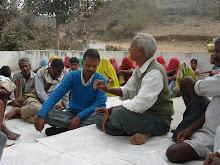.jpg)
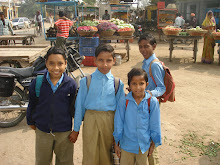.jpg)
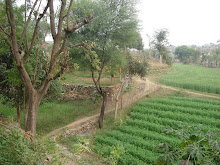.jpg)
